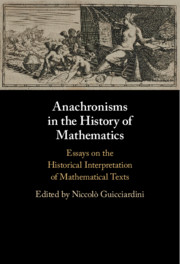 Anachronisms in the History of Mathematics
Anachronisms in the History of Mathematics Book contents
- Frontmatter
- Contents
- Contributors
- Figures
- Preface
- 1 Introduction: The historical interpretation of mathematical texts and the problem of anachronism
- 2 From reading rules to reading algorithms: textual anachronisms in the history of mathematics and their effects on interpretation
- 3 Anachronism and anachorism in the study of mathematics in India
- 4 On the need to re-examine the relationship between the mathematical sciences and philosophy in Greek antiquity
- 5 Productive anachronism: on mathematical reconstruction as a historiographical method
- 6 Anachronism in the Renaissance historiography of mathematics
- 7 Deceptive familiarity: differential equations in Leibniz and the Leibnizian school (1689–1736)
- 8 Euler and analysis: case studies and historiographical perspectives
- 9 Measuring past geometers: a history of non-metric projective anachronism
- 10 Anachronism: Bonola and non-Euclidean geometry
- 11 Anachronism and incommensurability:words, concepts, contexts, and intentions
- Index
2 - From reading rules to reading algorithms: textual anachronisms in the history of mathematics and their effects on interpretation
Published online by Cambridge University Press: 19 July 2021
- Frontmatter
- Contents
- Contributors
- Figures
- Preface
- 1 Introduction: The historical interpretation of mathematical texts and the problem of anachronism
- 2 From reading rules to reading algorithms: textual anachronisms in the history of mathematics and their effects on interpretation
- 3 Anachronism and anachorism in the study of mathematics in India
- 4 On the need to re-examine the relationship between the mathematical sciences and philosophy in Greek antiquity
- 5 Productive anachronism: on mathematical reconstruction as a historiographical method
- 6 Anachronism in the Renaissance historiography of mathematics
- 7 Deceptive familiarity: differential equations in Leibniz and the Leibnizian school (1689–1736)
- 8 Euler and analysis: case studies and historiographical perspectives
- 9 Measuring past geometers: a history of non-metric projective anachronism
- 10 Anachronism: Bonola and non-Euclidean geometry
- 11 Anachronism and incommensurability:words, concepts, contexts, and intentions
- Index
Summary
This chapter is devoted to what I call textual anachronism. By this expression, I refer to forms of anachronism that lead to interpreting ancient texts on the basis of anachronistic assumptions with respect to how these texts made sense for the ancient actors. This is, for instance, the case when historians take the textual components that they find in ancient documents (like a mathematical problem, an algorithm, a proof, and a diagram), as they would take what they consider to be modern counterparts, and interpret these components on that basis. I argue that this form of anachronism has caused misinterpretations of several kinds, which I identify and analyze, using examples from four historical contexts. I further discuss the historiographical implications of this type of anachronism. I conclude with the thesis that one can limit the effects of this form of anachronism by using a historical approach to forms of text. Moreover, a historical approach of this kind sheds light on the fact that anachronism has a history that might also be interesting to consider.
Keywords
Information
- Type
- Chapter
- Information
- Anachronisms in the History of MathematicsEssays on the Historical Interpretation of Mathematical Texts, pp. 42 - 82Publisher: Cambridge University PressPrint publication year: 2021
Accessibility standard: Unknown
- 4
- Cited by